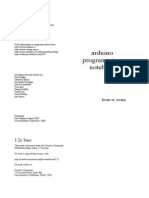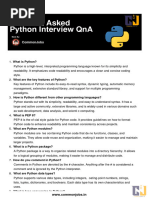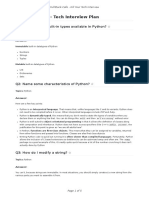0 ratings0% found this document useful (0 votes)
4 viewsPython Question
The document contains a series of Python programming questions and answers, categorized into basic, intermediate, and advanced levels, covering topics such as data types, loops, functions, decorators, and exception handling. It also includes interview questions addressing differences between Python versions, the Global Interpreter Lock, and garbage collection. Overall, it serves as a comprehensive guide for understanding Python concepts and preparing for interviews.
Uploaded by
arjun.v.it.2021Copyright
© © All Rights Reserved
Available Formats
Download as PDF, TXT or read online on Scribd
0 ratings0% found this document useful (0 votes)
4 viewsPython Question
The document contains a series of Python programming questions and answers, categorized into basic, intermediate, and advanced levels, covering topics such as data types, loops, functions, decorators, and exception handling. It also includes interview questions addressing differences between Python versions, the Global Interpreter Lock, and garbage collection. Overall, it serves as a comprehensive guide for understanding Python concepts and preparing for interviews.
Uploaded by
arjun.v.it.2021Copyright
© © All Rights Reserved
Available Formats
Download as PDF, TXT or read online on Scribd
You are on page 1/ 18
Python Question
Basic python Question
1. Question: What is Python?
Answer: Python is a high-level, interpreted programming
language known for its readability and simplicity.
2. Question: How do you print "Hello, World!" in Python?
Answer: You can print text using the print() function.
3. Question: How do you declare and assign a variable in
Python?
Answer: Variables are declared by assigning a value to a
name.
4. Question: What are data types in Python?
Answer: Data types define the type of value a variable
can hold. Common types include int, float, str, bool, and
more.
5. Question: How do you create a list in Python?
Answer: Lists are created using square brackets.
6. Question: What is a loop in Python?
Answer: A loop is a control structure that repeatedly
executes a block of code. The two common types are for
and while loops.
7. Question: How do you define a function in Python?
Answer: Functions are defined using the def keyword.
8. Question: What is an if statement in Python?
Answer: An if statement is used for conditional execution
of code based on a condition.
9. Question: How can you get user input in Python?
Answer: Use the input() function to get input from the user
10. Question: How do you comment code in Python?
Answer: Use the # symbol for single-line comments and
triple quotes (''') for multi-line comments.
Intermediate Level Python Question
1. Question: How do you reverse a list in Python?
Answer: You can reverse a list using slicing.
2. Question: What is a dictionary in Python?
Answer: A dictionary is a collection that stores key-value
pairs. It's defined using curly braces.
3. Question: How can you handle exceptions using
try-except blocks in Python?
Answer: Use try to enclose the code that might raise an
exception, and except to handle the exception.
4. Question: What is a generator in Python?
Answer: A generator is a type of iterable that generates
values on-the-fly, conserving memory.
5. Question: How can you read and write to a file in
Python?
Answer: You can use the built-in open() function to read
from and write to files.
6. Question: What is list comprehension in Python?
Answer: List comprehension is a concise way to create
lists using a single line of code.
7. Question: How can you sort a list of dictionaries based
on a specific key?
Answer: You can use the sorted() function with a custom
sorting key.
8. Question: What is the difference between shallow copy
and deep copy?
Answer: A shallow copy creates a new object but
references the same inner objects, while a deep copy
creates a new object and recursively copies all inner
objects.
9. Question: How do you work with modules and
packages in Python?
Answer: Modules are Python files containing functions,
classes, and variables. Packages are directories
containing multiple modules. You can use import to use
modules and packages.
10. Question: How can you work with virtual
environments in Python?
Answer: Virtual environments are isolated environments
for Python projects. You can create and manage them
using the venv module.
Advanced Level Python Question
1. Question: Explain the concept of decorators in Python.
Answer: Decorators are functions that modify the
behavior of other functions. They are often used to add
functionality to existing functions without modifying their
code directly
2. Question: How can you implement multithreading and
multiprocessing in Python?
Answer: Multithreading allows concurrent execution of
threads within a single process, while multiprocessing
involves running multiple processes. Python's threading
and multiprocessing modules can be used.
4. Question: How can you handle asynchronous
programming in Python using the asyncio module?
Answer: Asynchronous programming allows tasks to run
concurrently without blocking each other. Python's asyncio
module provides tools for managing asynchronous code
using async and await.
5. Question: How can you work with context managers
and the with statement in Python?
Answer: Context managers are used to allocate and
release resources automatically, ensuring proper setup
and cleanup. They are often used with the with statement.
6. Question: What are metaclasses in Python?
Answer: Metaclasses define the behavior of classes.
They are responsible for creating class instances and can
be thought of as classes for classes. By defining a custom
metaclass, you can control class creation and
modification.
7. Question: Explain the concept of descriptors in Python
and give an example.
Answer: Descriptors are objects that customize attribute
access. They implement the methods _get, __set, and
__delete_. They are used to create reusable and
customizable behavior for class attributes.
8. Question: How can you create and manage
user-defined exceptions in Python?
Answer: You can create custom exceptions by creating a
new class that inherits from the built-in Exception class.
This allows you to define your own error hierarchy and
handle specific errors in your code.
9. Question: Explain the concept of a generator and how
it differs from a regular function.
Answer: A generator is a type of iterable that generates
values on-the-fly using the yield keyword. Unlike regular
functions that execute and return a value, generators
pause and resume execution, saving memory and
improving efficiency.
Interview Question Based On Python
Question: Explain the differences between Python 2 and
Python 3.
Answer: Python 3 introduced several improvements and
changes, such as print being a function, improved Unicode
support, division returning float, and various library
updates.
Question: What is the Global Interpreter Lock (GIL) and
how does it impact multi-threading in Python?
Answer: The GIL is a mutex that allows only one thread to
execute in a process at a time. This can impact the
performance of multi-threaded CPU-bound programs but
does not affect I/O-bound tasks.
Question: How can you efficiently read a large file line by
line in Python?
Answer: Using a for loop with a file object efficiently reads
a file line by line, as it reads one line at a time and doesn't
load the entire file into memory.
Question: Explain the difference between a shallow copy
and a deep copy.
Answer: A shallow copy creates a new object and inserts
references to the same objects found in the original. A
deep copy creates a new object and recursively copies all
objects referenced by the original.
Question: What is a closure in Python?
Answer: A closure is a function that remembers values in
the enclosing scope even if they are not present in
memory. It "closes over" the free variables, retaining their
values.
Question: How can you handle exceptions and errors in
Python?
Answer: Exceptions can be handled using try and except
blocks. You can catch specific exceptions or use a more
general except block for handling unexpected errors.
Question: How does Python's garbage collection work?
Answer: Python's garbage collector automatically
reclaims memory occupied by objects that are no longer
referenced or reachable.
Question: What is a decorator in Python and how can you
use it?
Answer: A decorator is a higher-order function that allows
modifying or extending the behavior of other functions. It is
often used to add functionality to functions without
changing their source code.
Question: What is the purpose of the _init_ method in
Python classes?
Answer: The _init_ method is a constructor that initializes
the instance variables of a class when an object is
created.
Question: How can you create a generator in Python?
Answer: You can create a generator by using a function
with the yield keyword. Generators allow lazy evaluation of
values, conserving memory.
Question: Explain the purpose of the if _name_ ==
"_main_": statement in Python scripts.
Answer: This statement checks whether the script is
being run as the main program or imported as a module. It
ensures that the code inside the if block is executed only
when the script is run directly.
You might also like
- 300 Python Interview Questions and Solutions100% (1)300 Python Interview Questions and Solutions88 pages
- Important Interview Questions On Python With AutomationNo ratings yetImportant Interview Questions On Python With Automation5 pages
- Preparing For Your Python Interview - The Basics - Techwers (Your Technical Interview Book 2) - KT LindemannNo ratings yetPreparing For Your Python Interview - The Basics - Techwers (Your Technical Interview Book 2) - KT Lindemann83 pages
- Class 11 Question Bank Computer Science Chap 7 (2024-25)No ratings yetClass 11 Question Bank Computer Science Chap 7 (2024-25)27 pages
- 60 Most Toughest Python Interview Questions and AnswersNo ratings yet60 Most Toughest Python Interview Questions and Answers16 pages
- 100 Most Asked Python Interview QnA PDFNo ratings yet100 Most Asked Python Interview QnA PDF10 pages
- Application Development Using Python CA2No ratings yetApplication Development Using Python CA25 pages
- Top Python Interview Questions and AnswersNo ratings yetTop Python Interview Questions and Answers17 pages
- @codingexpert142 Zero To Py (2023 - New Release)100% (2)@codingexpert142 Zero To Py (2023 - New Release)258 pages
- A. Three Features That I Like in Python: CS320 - Assignment 01 1751048 - Khuu Kien AnNo ratings yetA. Three Features That I Like in Python: CS320 - Assignment 01 1751048 - Khuu Kien An4 pages
- 9. Introduction to Python Class 9 Questions and AnswersNo ratings yet9. Introduction to Python Class 9 Questions and Answers4 pages
- Python Interview Questions: Ans: .Py Files Contain The Source Code of A Program. Whereas, .Pyc File ContainsNo ratings yetPython Interview Questions: Ans: .Py Files Contain The Source Code of A Program. Whereas, .Pyc File Contains4 pages
- Fullstack - Cafe - Tech Interview Plan: Q1: What Are The Built-In Types Available in Python?No ratings yetFullstack - Cafe - Tech Interview Plan: Q1: What Are The Built-In Types Available in Python?5 pages
- Mastering Python 50 Specific Tips For Writing Better Code100% (1)Mastering Python 50 Specific Tips For Writing Better Code345 pages
- Q1.What Is Python? Can You Enlist The Benefits of Using Python?No ratings yetQ1.What Is Python? Can You Enlist The Benefits of Using Python?4 pages
- Internship Assignment 5: Name: Sudeshna Acharyya EmailNo ratings yetInternship Assignment 5: Name: Sudeshna Acharyya Email10 pages
- Studentsrokz - C Language Interview Papers Answers & Questions 2No ratings yetStudentsrokz - C Language Interview Papers Answers & Questions 23 pages
- Kiran Sir C/Python/C++/Ds Decision MakingNo ratings yetKiran Sir C/Python/C++/Ds Decision Making3 pages
- Data Structures Using C++ 2E: Pointers and Array-Based ListsNo ratings yetData Structures Using C++ 2E: Pointers and Array-Based Lists37 pages
- Intermediate Code Generation: CD: Compiler DesignNo ratings yetIntermediate Code Generation: CD: Compiler Design41 pages
- Standard C++ With Object-Oriented Programming BOOK CH 3No ratings yetStandard C++ With Object-Oriented Programming BOOK CH 344 pages
- PDF Microsoft Visual C 2010 An Introduction to Object Oriented Programming 4th Edition Joyce Farrell download100% (8)PDF Microsoft Visual C 2010 An Introduction to Object Oriented Programming 4th Edition Joyce Farrell download60 pages
- D Chapter 10 - Output Question PG 56-70No ratings yetD Chapter 10 - Output Question PG 56-7015 pages
- Important Interview Questions On Python With AutomationImportant Interview Questions On Python With Automation
- Preparing For Your Python Interview - The Basics - Techwers (Your Technical Interview Book 2) - KT LindemannPreparing For Your Python Interview - The Basics - Techwers (Your Technical Interview Book 2) - KT Lindemann
- Class 11 Question Bank Computer Science Chap 7 (2024-25)Class 11 Question Bank Computer Science Chap 7 (2024-25)
- 60 Most Toughest Python Interview Questions and Answers60 Most Toughest Python Interview Questions and Answers
- A. Three Features That I Like in Python: CS320 - Assignment 01 1751048 - Khuu Kien AnA. Three Features That I Like in Python: CS320 - Assignment 01 1751048 - Khuu Kien An
- 9. Introduction to Python Class 9 Questions and Answers9. Introduction to Python Class 9 Questions and Answers
- Python Interview Questions: Ans: .Py Files Contain The Source Code of A Program. Whereas, .Pyc File ContainsPython Interview Questions: Ans: .Py Files Contain The Source Code of A Program. Whereas, .Pyc File Contains
- Fullstack - Cafe - Tech Interview Plan: Q1: What Are The Built-In Types Available in Python?Fullstack - Cafe - Tech Interview Plan: Q1: What Are The Built-In Types Available in Python?
- Mastering Python 50 Specific Tips For Writing Better CodeMastering Python 50 Specific Tips For Writing Better Code
- Q1.What Is Python? Can You Enlist The Benefits of Using Python?Q1.What Is Python? Can You Enlist The Benefits of Using Python?
- Internship Assignment 5: Name: Sudeshna Acharyya EmailInternship Assignment 5: Name: Sudeshna Acharyya Email
- Studentsrokz - C Language Interview Papers Answers & Questions 2Studentsrokz - C Language Interview Papers Answers & Questions 2
- Data Structures Using C++ 2E: Pointers and Array-Based ListsData Structures Using C++ 2E: Pointers and Array-Based Lists
- Standard C++ With Object-Oriented Programming BOOK CH 3Standard C++ With Object-Oriented Programming BOOK CH 3
- PDF Microsoft Visual C 2010 An Introduction to Object Oriented Programming 4th Edition Joyce Farrell downloadPDF Microsoft Visual C 2010 An Introduction to Object Oriented Programming 4th Edition Joyce Farrell download

























































































